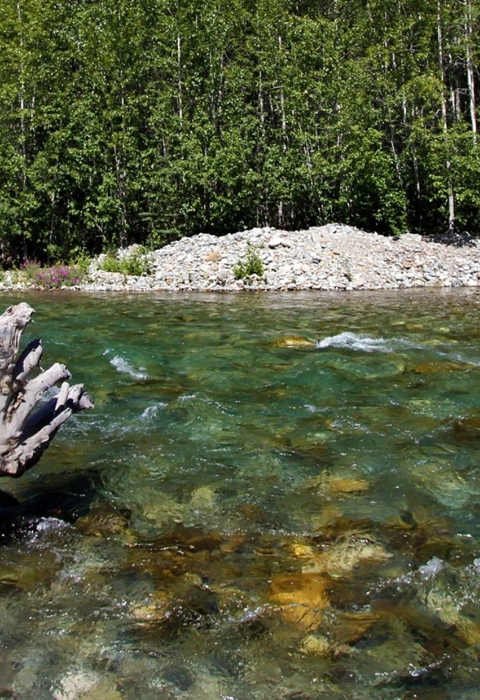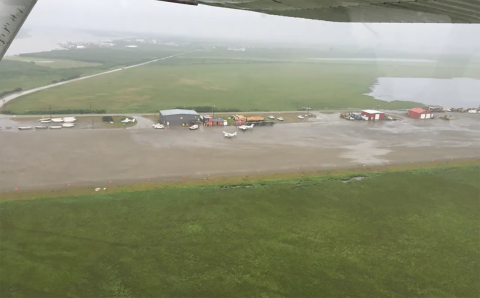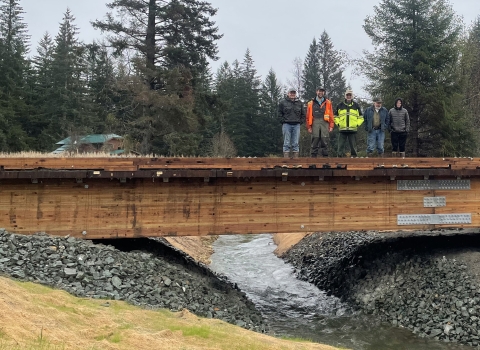Efforts to remove salmon migration barriers in Alaska will receive an additional $7.5 million in Bipartisan Infrastructure Law Bipartisan Infrastructure Law
The Bipartisan Infrastructure Law (BIL) is a once-in-a-generation investment in the nation’s infrastructure and economic competitiveness. We were directly appropriated $455 million over five years in BIL funds for programs related to the President’s America the Beautiful initiative.
Learn more about Bipartisan Infrastructure Law (BIL) funds. These funds build on prior BIL investments in 2022 and 2023 (and years-long collaboration between many partners) to restore fish passage fish passage
Fish passage is the ability of fish or other aquatic species to move freely throughout their life to find food, reproduce, and complete their natural migration cycles. Millions of barriers to fish passage across the country are fragmenting habitat and leading to species declines. The U.S. Fish and Wildlife Service's National Fish Passage Program is working to reconnect watersheds to benefit both wildlife and people.
Learn more about fish passage and protect Alaska communities from flooding where roads cross streams. This most recent round of funding will go towards projects in Southeast Alaska, the Mat-Su Valley, and along the Yukon River.
Southeast Alaska ($4 million)
Project page:Southeast Alaska Community and Tribal Fish Passage Project
This project restores passage to high-quality salmon habitat by addressing barriers at 11 culverts on Tribal-owned and non-federal lands across Southeast Alaska. Fish passage restoration at these sites are regional priorities, as identified by the Southeast Alaska Watershed Coalition's Watershed Prioritization and local Tribal and community groups. These priorities are based on their ecological benefits and benefits to local communities, including restoration of depressed stocks of culturally-important subsistence salmon. Aquatic organism passage assessment, implementation, and effectiveness monitoring in this project supports a regional strategy to address fish passage needs at a landscape scale through capacity building and empowerment of Tribal and community groups in Southeast Alaska.
Mat-Su Valley ($3 million)
Project page: Upper Moose Creek Watershed Fish Passage Project
Chickaloon Native Village, an Ahtna Tribe, is working to restore natural hydrologic and ecological function throughout the Moose Creek watershed. Moose Creek is a culturally important anadromous stream that was negatively impacted by mines and a railroad in the early 1900s. This project will design in-stream and floodplain salmon habitat restoration for up to five miles of upper Moose Creek; implement phase one of upper Moose Creek habitat restoration to remove in-stream velocity barriers in up to one mile of Moose Creek; and replace three barrier culverts and restore fish passage on three upper Moose Creek tributaries. This project will restore fish access to 28 miles of salmon spawning and rearing habitats and will restore floodplain connectivity for approximately 1,536 acres.
Emmonak ($500,000)
Project page:Fish Passage Barrier Removal in Emmonak, Alaska
This project will mitigate threats to critical salmon habitat in the Yukon River Delta by removing fish passage barriers on Emmonak Slough and its tributaries, an anadromous stream that is used by five Pacific salmon species; completing inventory and assessment of fish passage barriers in the community of Emmonak; engaging stakeholders to prioritize future fish passage barrier projects for the area; and collaborating with project partners and the local community to carry out a stream clean up and streambank revegetation in Emmonak Slough. The project activities will restore aquatic connectivity to high quality habitat and facilitate community-led stewardship of salmon streams in Emmonak. (Read more about our Gravel to Gravel Keystone Initiative for people, salmon, and the land).








